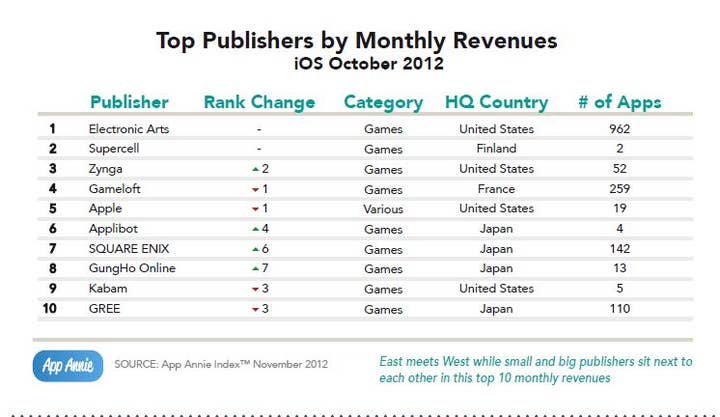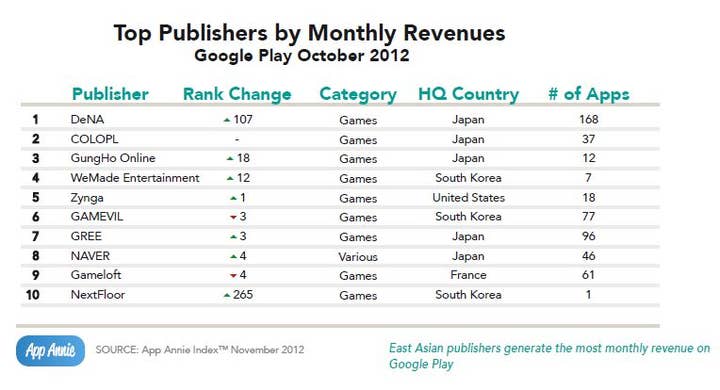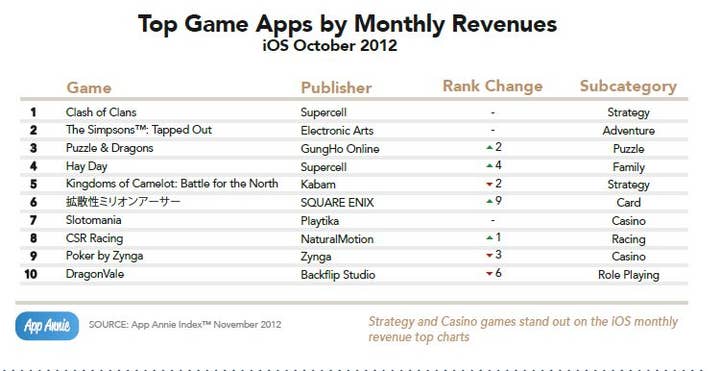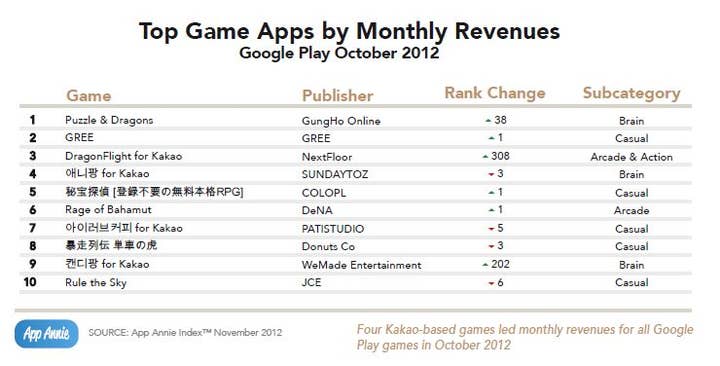Growth of Asian app sales a "major tectonic shift"
App Annie on the rise and rise of East Asian revenues, Google Play, Supercell and more
The rapid growth and change in the mobile gaming industry has developers eager to find out the hard data that can be used to guide strategy. Making reasonable sales projections depends on knowing just what the competition is selling, and where. Executives, analysts and investors have all bemoaned the dearth of digital distribution data. Now there's some light being shed on that darkness on a monthly basis by App Annie, which bills itself as the industry leader in app store analytics and market intelligence for the global app economy.
App Annie has unveiled the App Annie Index, a monthly report that charts and analyzes major revenue and download trends within the iOS and Google Play stores worldwide. App Annie is also unveiling App Annie's Weekly Top Gainers, which provides weekly insights into the world's most popular apps from its Store Stats service that is used by more than 80 percent of the Top 100 iOS publishers by revenue. The data being gathered covers more than 150,000 apps, and the company claims that it tracks more downloads and revenues than any other app store market data company - to date, over 11 billion downloads and more than $1.5 billion in app store publisher revenues.
GamesIndustry International spoke with App Annie's CEO Bertrand Schmitt, and Oliver Lo, VP of marketing, about the company's business and some of the startling data revealed in the premier edition of the App Annie Index; the complete report can be viewed here.

App Annie has been revealing some of its market data at conferences, but that was to a limited audience. "We believed we should go to the next step and distribute our information to a larger audience," says Schmitt. Lo explains the reasoning behind the decision: "Our objective as a company is to better inform the business decisions of the app industry. We've got a lot of customers using our data, but we really want the wider industry to learn from the insights that we're garnering each month."
App Annie gets its data through a different process than some other analytics firms. Some firms provide an SDK to app developers, who include the code in their game. The game then sends back data both to the developer and to the analytics firm. "Using an SDK can be tricked in so many ways," Schmitt says. "What we do is have the publisher give us their credentials, so we can connect on their behalf on the back end system of the store. We collect the data from iOS or Google Play, so the data we collect is really the primary source of data. Our data is coming from the store itself. You cannot get the same precision with an SDK-based solution."
"Japan has seen rapid revenue growth in the last few months, which demonstrates that the ARPU has been significantly higher than in other countries"
The amount of data and the quality of the data are important factors, since App Annie uses that information to analyze the entire market. "We get data from 40 percent of the top 100 publishers on iOS, and we have tracked more than $1.5 billion in revenues distributed by the stores," adds Schmitt. "Of the top 15 publishers by revenue, 10 are buying our market data, and use our data to drive their business." Lo notes the breadth of the information provided: "App Annie creates from a statistical model of the entire market very accurate download and revenue estimates for the entire app store, across all apps, all publishers, segmented by category, by country".

"We decided we want to open up some of that data to the public," says Lo of the Index. "We decided we wanted to take our data and form a rankings chart, ranking the app stores by the different platforms, the different countries, the different publishers, and the different apps, so you can see on a monthly basis how each of those four segments are doing. What are the top publishers in the world, what are top monetizing countries, and how this changes on a monthly basis.
"In this first report what we've found is fascinating. For the month of October, it's the first time on one of the major platforms that the US has been ousted from the top spot in download revenues," says Lo. "In Google Play, for revenue, in the last month Japan has overtaken the US. It's really demonstrating a balance of power shift in the app stores towards East Asian audiences and East Asian publishers."
This marks the first time the US did not rank number one for revenues on Google Play. Since January 2012, Japanese app revenues on Google Play have multiplied by more than 10 times while US revenues have merely doubled. On iOS, revenue in Japan is still well behind the US - 14.4 percent compared to 32.7 percent respectively. However, Japan is catching up month-by-month, with the country taking an increasingly larger share of global revenue and the US taking an increasingly smaller share.
"EA and Zynga have hundreds of apps; EA has 952 apps on the store, whereas Supercell just has two apps"
"Japan has seen rapid revenue growth in the last few months, which demonstrates that the average revenue per user has been significantly higher than in other countries given that download volume in Japan is a only a quarter that of the US," offers Schmitt. "This represents a major tectonic shift in the international app store economy, and one that I'm sure publishers will be looking to take advantage of."
Lo notes the overall strength of Japan and Korea at selling apps. "The East Asian publishers are really beginning to dominate the app store charts, both in terms of apps and revenue. The top ten is 90 percent Japanese and Korean publishers; six months ago that would have been unheard of."

The gap in revenues between iOS apps and Android apps is still large, but it's shrinking. "Looking at a platform comparison, we looked at iOS revenues versus Google Play, revenues for iOS are still four times that of Google Play, but Google Play is growing a lot faster. In the year to date, Google Play revenues grew 311 percent, compared to iOS which only grew 12.9 percent," says Lo.
Lo also points out the disparity between some of the leading app developers. "The other interesting insight on the publisher level was looking at individual publishers and how they monetize. If you look at the top publisher chart by revenue on iOS, the number one, two, and three is EA, Supercell, and Zynga. EA and Zynga have hundreds of apps; EA has 952 apps on the store, whereas Supercell just has two apps. It's really showing the difference in monetization and business strategies of big companies who have massive distribution and are monetizing to that, and much smaller companies with breakout hits that are are earning as much if not more off just a couple of apps."
Knowledge of the market data is critical to making the right decisions as a developer. "It's so easy to think that because you grow 50 percent a month, it's great, but you can see in some countries the growth rates are even higher than that. You always want to compare yourself to the growth of the market," Schmitt adds.
The concentration of revenue among developers varies depending on the market. "The more mature the market, the higher the distribution between apps. If you take a newer market like Japan, where ARPU is very high, the top apps are generating a disproportionate amount of revenues versus apps after them," says Schmitt. Lo offers the example: "To give you an idea of scale on that, in the most recent month if you took the top ten apps in Japan by a monthly revenue basis, they represent more than 40 percent of the total revenue of the store. Five months ago that was maybe 20 percent. Japan is very top-heavy as an app market."
"We looked at the top apps by revenue for the last month on Google Play," offers Lo. "All of them, without exception, were from either Japanese or Korean publishers. Many of those apps are only monetizing off of their local audiences."

Tablets are definitely an important growth area. "We have a breakdown between iPhone and iPad. The iPad is not popular yet in Japan because of the size," says Schmitt. "We are pretty excited there will be a huge growth in Japan through all of these 7, 8 inch tablets - iPad Mini, Nexus 7 and the like. We believe the market will grow very big in Japan next year. On tablets you definitely spend much more time when playing a game. What this means if you spend more time and have a bigger screen, people are ready to spend more money so ARPU can be much higher."
Schmitt and Lo have advice developers for 2013 and beyond. "Don't try to do too many games at once," says Schmitt. "Focus on just a few very high-quality apps, where you know the virality and are very good at monetizing your users, that's the first step. The second step, definitely, is you must have a version for Google Play. The more valuable your app is, the more you want to be able to play with all your friends. The last point is we will witness an explosion in tablets, and something that does well in the 10 inch form factor is important. Especially in Google Play you need to make sure your apps run on very many devices, and that's not something to underestimate."
"We will witness an explosion in tablets, and something that does well in the 10 inch form factor is important"
"On the international front, previously a lot of publishers would see the strategy as developing the game for an English language audience, and then going from that to try and localize the app for Asia and other places as well," adds Lo. "What we're seeing with our data is there's almost been a balance of power shift in where the revenues are coming from, particularly for Google Play and to a certain extent on iOS as well. I think that shift is really moving towards East Asia. I think developers who aren't from Asia need to think about Asia not as an add-on, but it should be a core part of their strategy. If they really want to be earning the scale of revenues that puts them in the upper echelon of developers, you can't get their without Asia. The top ten apps on Google Play, they're all Asian apps."
"Distribution in Korea and Japan has really been changing this year. The way you distribute and make your apps successful in East Asia right now is through messaging platforms, like Kakao and Line. You have to be ready to change as the market changes," says Schmitt. "Two years ago, fifty percent of the business was coming from the US, if not more. That is a big shift. Things will keep moving."

